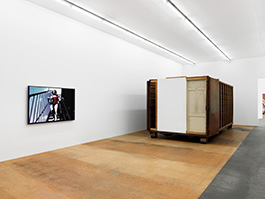
| français I english |
| October 12, 2016—January 29, 2017 |
|
Gordon Matta-Clark |
Gordon Matta-Clark (1943-1978) explored all manner of media: performance, drawing, sculpture, photography and film. Owing to the specific medium that brought them all together – decrepit buildings – few ‘things’ are left of his work. Yet these ‘remains’ are more than just traces, for they form a whole that still has political, social and aesthetic relevance. Despite his early death at the age of 35, Gordon Matta-Clark left a visionary legacy, an active dialogue developed through, and in opposition to, architecture: ‘anarchitecture’, ‘non-uments’, and ‘mental projectiles’ – a multifaceted view of ‘imminent ruins.’ In May 1972, Gordon Matta-Clark created Open House, a short-lived work produced in a street in New York’s SoHo neigbourhood, between 98 and 112 Greene Street, two alternative exhibition spaces that opened in 1969 and 1970 respectively. This work continued his investigations of garbage recycling, using a dumpster that he divided up with wooden partitions – doors from hotels and restaurants that were about to be demolished. Open House also owes its name to the opening in the façade and the lack of a roof, producing osmosis and permeability in the created space, the street, the buildings. Open House instantly became an experimental, playful center for dancers, performers, and artists. Providing more freedom than alternative exhibition spaces, it was an urban equivalent to the works created in connection with land art. An eponymous Super-8 film made on the opening day documents the public’s confrontation with this ‘place thing’ or ‘personal spatial epiphany’, as Richard Nonas put it, as well as its appearance on the margins of a prosperous, established New York whose skyscrapers are just discernible in the background. The poet Ted Greenwald recorded the sound of his truck doing delivery rounds for the Village Voice newspaper: ‘Even though it can’t move, Open House now has an engine and a sound – the sound of a team at work.’ In October 1972, a second version of Open House was set up outside 112 Greene Street, where Matta-Clark had an exhibition from 21 October to 10 November. The coincidence in place and time made this new event a counterpart to the spaces at 112 Greene Street, which the artist covered with pictures of peeling, decrepit and yet attractive façades, giving the indoor space a street-like appearance. The larger container, made of irregular, deconstructed partitions, had an open flight of steps leading to a plateform with a brasero that occupied half of the structure. What Matta-Clark was trying to do here was juxtapose the disparaged world of urban wastelands and a festive activity perceived as typically suburban – a barbecue – in order to change the city. Although, being events and conceptual projects connected with the recycling and ‘contenairisation’ of living spaces, the first two versions of the work did not survive, the Gordon Matta-Clark Estate, aware that there were few of the artist’s spatial inventions still in existence, decided after his death to give his work and it way of presentation a lasting form. The permanent version, described in a detailed brief, made use of the industrial container from the second reconstitution of the work during Gordon Matta-Clark: a Retrospective, held at the Museum of Contemporary Art, Chicago, in 1985. This has now found a legitimate place at MAMCO in the exhibition space La Rue, close to Christo’s Corridor Store Front (Matta-Clark assisted Christo on several occasions, particularly when he was building his Store Fronts). |
 |
From left to right: Gordon Matta-Clark, Open House, 1972, MAMCO collection and Open House, 1972-1985-1994, MAMCO collection. Photo: Annik Wetter—MAMCO, Geneva. |